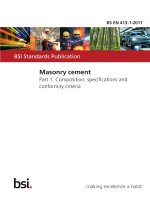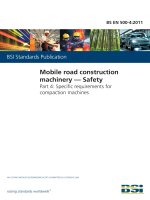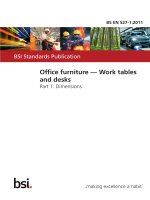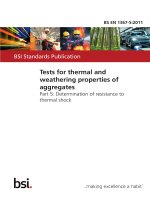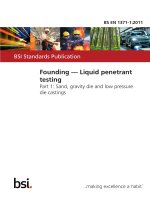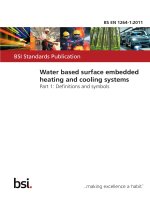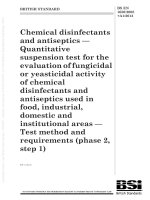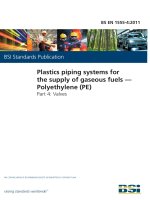Bsi bs en 62271 103 2011 (2013)
Bạn đang xem bản rút gọn của tài liệu. Xem và tải ngay bản đầy đủ của tài liệu tại đây (1.79 MB, 72 trang )
BS EN 62271-103:2011
Incorporating corrigendum October 2013
BSI Standards Publication
High-voltage switchgear
and controlgear
Part 103: Switches for rated voltages
above 1 kV up to and including 52 kV
BS EN 62271-103:2011 BRITISH STANDARD
National foreword
This British Standard is the UK implementation of EN 62271-103:2011.
It is identical to IEC 62271-103:2011, incorporating corrigendum
October 2013. It supersedes BS EN 60265-1:1998, which will be
withdrawn on 21 July 2014.
The start and finish of text introduced or altered by corrigendum is
indicated in the text by tags. Text altered by IEC corrigendum October
2013 is indicated in the text by ˆ‰.
The UK participation in its preparation was entrusted by Technical
Committee PEL/17, Switchgear, controlgear, and HV-LV co-ordination,
to Subcommittee PEL/17/1, High-voltage switchgear and controlgear.
A list of organizations represented on this subcommittee can be obtained
on request to its secretary.
This publication does not purport to include all the necessary provisions of
a contract. Users are responsible for its correct application.
© The British Standards Institution 2013. Published by BSI Standards
Limited 2013
ISBN 978 0 580 84731 8
ICS 29.130.10
Compliance with a British Standard cannot confer immunity from
legal obligations.
This British Standard was published under the authority of the
Standards Policy and Strategy Committee on 30 September 2011.
Amendments/corrigenda issued since publication
Date Text affected
31 December 2013 Implementation of IEC corrigendum October 2013
EUROPEAN STANDARD EN 62271-103
NORME EUROPÉENNE
EUROPÄISCHE NORM September 2011
ICS 29.130.10 English version
High-voltage switchgear and controlgear -
Part 103: Switches for rated voltages above 1 kV
up to and including 52 kV
(IEC 62271-103:2011)
Appareillage à haute tension - Hochspannungs-Schaltgeräte und -
Partie 103: Interrupteurs pour tensions Schaltanlagen -
assignées supérieures à 1 kV et Teil 103: Lastschalter für
inférieures ou égales à 52 kV Bemessungsspannungen über 1 kV bis
(CEI 62271-103:2011) einschließlich 52 kV
(IEC 62271-103:2011)
This European Standard was approved by CENELEC on 2011-07-21. CENELEC members are bound to comply
with the CEN/CENELEC Internal Regulations which stipulate the conditions for giving this European Standard
the status of a national standard without any alteration.
Up-to-date lists and bibliographical references concerning such national standards may be obtained on
application to the Central Secretariat or to any CENELEC member.
This European Standard exists in three official versions (English, French, German). A version in any other
language made by translation under the responsibility of a CENELEC member into its own language and notified
to the Central Secretariat has the same status as the official versions.
CENELEC members are the national electrotechnical committees of Austria, Belgium, Bulgaria, Croatia, Cyprus,
the Czech Republic, Denmark, Estonia, Finland, France, Germany, Greece, Hungary, Iceland, Ireland, Italy,
Latvia, Lithuania, Luxembourg, Malta, the Netherlands, Norway, Poland, Portugal, Romania, Slovakia, Slovenia,
Spain, Sweden, Switzerland and the United Kingdom.
CENELEC
European Committee for Electrotechnical Standardization
Comité Européen de Normalisation Electrotechnique
Europäisches Komitee für Elektrotechnische Normung
Management Centre: Avenue Marnix 17, B - 1000 Brussels
© 2011 CENELEC - All rights of exploitation in any form and by any means reserved worldwide for CENELEC members.
Ref. No. EN 62271-103:2011 E
BS EN 62271-103:2011
EN 62271-103:2011
Foreword
The text of document 17A/961/FDIS, future edition 1 of IEC 62271-103, prepared by SC 17A,
High-voltage switchgear and controlgear, of IEC TC 17, Switchgear and controlgear, was submitted to the
IEC-CENELEC parallel vote and was approved by CENELEC as EN 62271-103 on 2011-07-21.
This European Standard supersedes EN 60265-1:1998.
EN 62271-103:2011 includes the following significant technical changes with respect to
EN 60265-1:1998:
– the rated voltage of 52 kV is now included;
– the document is aligned with EN 62271-1 and EN 62271-100;
– addition of a test procedure for short-circuit making tests;
– introduction of notion of NSDD (non-sustained disruptive discharge) as defined in EN 62271-1 and
restrikes;
– new classes C1 and C2 for capacitive switching;
– new Annex A defining tolerances.
Attention is drawn to the possibility that some of the elements of this document may be the subject of
patent rights. CEN and CENELEC shall not be held responsible for identifying any or all such patent
rights.
The following dates were fixed:
– latest date by which the EN has to be implemented (dop) 2012-04-21
at national level by publication of an identical
national standard or by endorsement
– latest date by which the national standards conflicting (dow) 2014-07-21
with the EN have to be withdrawn
Annexes ZA and ZB have been added by CENELEC.
__________
Endorsement notice
The text of the International Standard IEC 62271-103:2011 was approved by CENELEC as a European
Standard without any modification.
In the official version, for Bibliography, the following notes have to be added for the standards indicated:
IEC 60059 NOTE Harmonized as EN 60059.
IEC 60071-1:2006 NOTE Harmonized as EN 60071-1:2006 (not modified).
IEC 62271-105 NOTE Harmonized as EN 62271-105.
IEC 60507 NOTE Harmonized as EN 60507.
__________
BS EN 62271-103:2011
EN 62271-103:2011
Annex ZA
(normative)
Normative references to international publications
with their corresponding European publications
The following referenced documents are indispensable for the application of this document. For dated
references, only the edition cited applies. For undated references, the latest edition of the referenced
document (including any amendments) applies.
NOTE When an international publication has been modified by common modifications, indicated by (mod), the relevant EN/HD
applies.
Publication Year Title EN/HD Year
IEC 60050-441 1984 - -
International Electrotechnical Vocabulary
IEC 60529 1989 (IEV) - EN 60529 1991
IEC 62271-1 2007 Chapter 441: Switchgear, controlgear and + corr. May 1993
IEC 62271-100 2008 fuses EN 62271-1 2008
IEC 62271-102 2001
Degrees of protection provided EN 62271-100 2009
IEC 62271-110 2009 by enclosures (IP Code)
EN 62271-102 2002
High-voltage switchgear and controlgear - + corr. July 2008
Part 1: Common specifications + corr. March 2005
EN 62271-110 2009
High-voltage switchgear and controlgear -
Part 100: Alternating current circuit-breakers
High-voltage switchgear and controlgear -
Part 102: Alternating current disconnectors
and earthing switches
High-voltage switchgear and controlgear -
Part 110: Inductive load switching
BS EN 62271-103:2011
EN 62271-103:2011
Annex ZB
(informative)
A-deviations
A-deviation: National deviation due to regulations, the alteration of which is for the time being outside the
competence of the CENELEC member.
This European Standard does not fall under any Directive of the EC.
In the relevant CENELEC countries these A-deviations are valid instead of the provisions of the European
Standard until they have been removed.
Clause Deviation
1.1 Italy
(I.S.P.E.S.L. (*) Rules, 95 revision: VSR.8.B.1; VSR.8.B.2; M.15.D.2 to .4.)
For high-voltage alternating current circuit-breakers containing gas-filled compartments,
the design pressure is limited to a maximum of 0,5 bar (gauge) and the volume is limited
to a maximum of 2 m3. Gas filled compartments having a design pressure exceeding
0,5 bar (gauge) or a volume exceeding 2 m3 shall be designed according to Italian
pressure vessel code for electrical switchgear (DM 1 December 1980 and DM
10 September 1981 published on Gazzetta Ufficiale n° 285 dated 16.10.1981). This
requirement is not applicable for gas filled compartments having a design pressure
exceeding 0,5 bar (gauge) but a volume not exceeding 25 dm3.
Italian laws apply to gas pressurized enclosures made of both insulating and metallic
materials with a capacity of 25 liters or above, a design pressure higher than 0,05 kg/cm2
and a temperature range: -25 °C/+100 °C (only for insulating materials).
Moreover, the manufacturer of any electrical equipment, which comprehends gas-
pressurized enclosures, must submit the design of the pressurized enclosures itself to a
proper legal Authority indicating the stresses and the loads which have any influence on
the design itself. For each of the stresses the manufacturer must indicate the design
values and the relevant computations.
Only the use of porcelain type A or S (Aluminous or Siliceous) is permitted.
(*) I.S.P.E.S.L.: Istituto Superiore per la Prevenzione e la Sicurezza del Lavoro.
BS EN 62271-103:2011
62271-103 IEC:2011
CONTENTS
1 General . ..........................................................................................................................................8
1.1 Scope. ...................................................................................................................................8
1.2 Normative references . ........................................................................................................8
2 Normal and special service conditions . ......................................................................................9
3 Terms and definitions . ..................................................................................................................9
3.1 General terms . ....................................................................................................................9
3.2 Assemblies of switchgear and controlgear . .....................................................................9
3.3 Parts of assemblies .............................................................................................................9
3.4 Switching devices . ...............................................................................................................9
3.5 Parts of switchgear and controlgear . ............................................................................. 11
3.6 Operation . .......................................................................................................................... 11
3.7 Characteristic quantities . ................................................................................................. 11
3.8 Index of definitions . .......................................................................................................... 13
4 Ratings .......................................................................................................................................... 14
4.1 Rated voltage (Ur) . ........................................................................................................ 14
4.2 Rated insulation level . .................................................................................................. 15
4.3 Rated frequency (fr) . ...................................................................................................... 15
4.4 Rated normal current and temperature rise . ..............................................................15
4.5 Rated short-time withstand current (Ik) . ..................................................................... 15
4.6 Rated peak withstand current (Ip) . .............................................................................. 15
4.7 Rated duration of short-circuit (tk) . .............................................................................. 15
4.8 Rated supply voltage of closing and opening devices and of auxiliary and
control circuits (Ua) . ....................................................................................................... 15
4.9 Rated supply frequency of closing and opening devices and of auxiliary
circuits. ............................................................................................................................ 15
4.10 Rated pressure of compressed gas supply for controlled pressure systems . .......15
4.11
4.101 Rated filling levels for insulation and/or operation . ...................................................15
4.102
4.103 Rated mainly active load-breaking current (Iload) . ....................................................15
4.104 Rated closed-loop breaking current (Iloop and Ipptr). .................................................16
4.105 Rated cable-charging breaking current (Icc) . .............................................................16
Rated line-charging breaking current (Ilc) ..................................................................16
4.106 Rated single capacitor bank breaking current for special purpose switches
(Isb) . ................................................................................................................................. 16
4.107 Rated back-to-back capacitor bank breaking current for special purpose
switches (Ibb). ................................................................................................................. 16
4.108 Rated back-to-back capacitor bank inrush making current for special
4.109 purpose switches (Iin) . .................................................................................................. 16
4.110 Rated earth fault breaking current (Ief1) . .................................................................... 16
4.111 Rated cable- and line-charging breaking current under earth fault
4.112 conditions (Ief2) .............................................................................................................. 17
4.113
4.114 Rated motor breaking current for special purpose switches (Imot) . ........................17
4.115 Rated short-circuit making current (Ima) . .................................................................... 17
Rated breaking and making currents for a general purpose switch . .......................17
Ratings for limited purpose switches ........................................................................... 18
Ratings for special purpose switches .......................................................................... 18
Ratings for switches backed by fuses . .......................................................................18
BS EN 62271-103:2011
62271-103 IEC:2011
4.116 Type and classes for general purpose, limited purpose and special purpose
switches . ......................................................................................................................... 18
5 Design and construction . ...........................................................................................................19
5.1 Requirements for liquids in switchgear and controlgear . .........................................19
5.2 Requirements for gases in switchgear and controlgear . ..........................................19
5.3 Earthing of switchgear and controlgear . .....................................................................19
5.4 Auxiliary and control equipment ................................................................................... 19
5.5 Dependent power operation . ........................................................................................ 19
5.6 Stored energy operation . .............................................................................................. 19
5.7 Independent manual or power operation (independent unlatched operation) . ......19
5.8 Operation of releases . .................................................................................................. 19
5.9 Low- and high-pressure interlocking and monitoring devices. .................................19
5.10 Nameplates . ................................................................................................................... 19
5.11 Interlocking devices . ...................................................................................................... 21
5.12 Position indication . ........................................................................................................ 21
5.13 Degrees of protection provided by enclosures . .........................................................21
5.14 Creepage distances for outdoor insulators .................................................................21
5.15 Gas and vacuum tightness............................................................................................ 21
5.16 Liquid tightness .............................................................................................................. 21
5.17 Fire hazard (flammability) ............................................................................................. 22
5.18 Electromagnetic compatibility (EMC) .......................................................................... 22
5.19 X-ray emission. ............................................................................................................... 22
5.20 Corrosion. ........................................................................................................................ 22
5.101 Making and breaking operations . ................................................................................ 22
5.102 Requirements for switch-disconnectors. .....................................................................22
5.103 Mechanical strength. ...................................................................................................... 22
5.104 Securing the position ..................................................................................................... 22
5.105 Auxiliary contacts for signalling.................................................................................... 22
5.106 No-load transformer breaking . ..................................................................................... 23
6 Type tests . ................................................................................................................................... 23
6.1 General . ............................................................................................................................. 23
6.1.1 Grouping of tests . ................................................................................................ 23
6.1.2 Information for identification of specimens . .....................................................24
6.1.3 Information to be included in the type-test reports . ........................................24
6.1.101Reference no-load test . ...................................................................................... 24
6.2 Dielectric tests . ................................................................................................................. 24
6.3 Radio interference voltage (r.i.v.) test. ........................................................................... 24
6.4 Measurement of the resistance of circuits . .................................................................... 24
6.5 Temperature-rise tests ..................................................................................................... 24
6.6 Short-time withstand current and peak withstand current tests . ................................24
6.7 Verification of the protection ............................................................................................ 25
6.8 Tightness tests . ................................................................................................................. 25
6.9 Electromagnetic compatibility (EMC) tests . ................................................................... 25
6.10 Additional tests on auxiliary and control circuits . .........................................................25
6.10.1 General . ................................................................................................................ 25
6.10.2 Functional tests . .................................................................................................. 25
6.10.3 Electrical continuity of earthed metallic parts test . .........................................25
6.10.4 Verification of the operational characteristics of auxiliary contacts . .............25
6.10.5 Environmental tests ............................................................................................. 25
BS EN 62271-103:2011
62271-103 IEC:2011
6.10.6 Dielectric test . ...................................................................................................... 25
6.11 X-radiation test procedure for vacuum interrupters . ....................................................25
6.101 Making and breaking tests ............................................................................................ 26
6.101.1 Test duties for general purpose switches . ..................................................26
6.101.2 Test duties for limited purpose switches . ....................................................28
6.101.3 Test duties for special purpose switches . ...................................................28
6.101.4 Arrangement of the switch for tests . ............................................................30
6.101.5 Earthing of test circuit and switch.................................................................30
6.101.6 Test parameters . ............................................................................................. 31
6.101.7 Test circuits ..................................................................................................... 33
6.101.8 Behaviour of switch during breaking tests . .................................................46
6.101.9
Condition of switch after breaking tests and short-circuit making
tests. ................................................................................................................. 47
6.101.10 Type-test reports............................................................................................. 48
6.102 Mechanical and environmental tests ........................................................................... 49
6.102.1 Miscellaneous provisions for mechanical and environmental tests . ........49
6.102.2 Mechanical operation test at ambient air temperature ..............................51
6.102.3 Low and high temperature tests . ..................................................................52
6.102.4 Humidity test on auxiliary and control circuits . .................................................52
6.102.5 Operation under severe ice conditions ........................................................58
6.102.6
Tests to verify the proper functioning of the position indicating
device ............................................................................................................... 58
7 Routine tests ................................................................................................................................ 59
7.101 Mechanical operating tests . ......................................................................................... 59
8 Guide to the selection of switchgear and controlgear . ...........................................................60
8.101 General . .......................................................................................................................... 60
8.102 Conditions affecting application ................................................................................... 60
8.103 Insulation coordination. ................................................................................................. 60
8.104 Selection of class of switch . ......................................................................................... 60
8.104.1 General purpose switch . ............................................................................... 60
8.104.2 Limited purpose switch................................................................................... 61
8.104.3 Special purpose switch . ................................................................................ 61
8.105 Tests for special applications. ...................................................................................... 61
9 Information to be given with inquiries, tenders and orders . ..................................................61
9.1 Information to be given with inquiries and orders .........................................................61
9.2 Information to be given with tenders . ............................................................................. 62
10 Transport, storage, installation, operation and maintenance ................................................63
11 Safety. ........................................................................................................................................... 63
12 Influence of the product on the environment ........................................................................... 63
Annex A (normative) Tolerances on test quantities for type tests . ............................................64
Bibliography......................................................................................................................................... 66
Figure 1 – Three-phase test circuit for mainly active load current switching for test
duty TDload .......................................................................................................................................... 34
Figure 2 – Single-phase test circuit for mainly active load current switching for test
duty TDload .......................................................................................................................................... 35
Figure 3 – Three-phase test circuit for distribution line closed-loop and parallel
transformer current switching test for test duties TDloop and TDpptr . ..........................................37
BS EN 62271-103:2011
62271-103 IEC:2011
Figure 4 – Single-phase test circuit for distribution line closed-loop and parallel
transformer current switching test, for test duties TDloop and TDpptr . .........................................37
Figure 5 – General test circuit for three- and single-phase capacitive switching tests. ............42
Figure 6 – Prospective TRV parameter limits for capacitor bank current breaking tests . ........44
Figure 7 – Three-phase test circuit for earth fault breaking current tests, for test duty
TDef1 . ................................................................................................................................................... 45
Figure 8 – Three-phase test circuit for cable-charging breaking current tests under
earth fault conditions, for test duty TDef2 . ...................................................................................... 45
Figure 9 – Three-phase test circuit for short-circuit making current test for test duty
TDma . ................................................................................................................................................... 46
Figure 10 – Single-phase test circuit for short-circuit making current test for test duty
TDma . ................................................................................................................................................... 46
Figure 11 – Test sequences for low and high temperature tests . ................................................53
Figure 12 – Humidity test . ................................................................................................................. 57
Table 1 – Preferred values of rated line- and cable-charging breaking currents for
general purpose switch . .................................................................................................................... 17
Table 2 – Product information . ......................................................................................................... 20
Table 3 – Test duties for general purpose switches – Test duties for three-phase tests
on three-pole operated, switches . .................................................................................................. 26
Table 4 – Test duties for general purpose switches – Single phase tests on three-pole
switches operated pole-after-pole and single-pole switches applied on three-phase
systems . .............................................................................................................................................. 27
Table 5 – Test duties for special purpose switches – Three-phase tests on three-pole
operated, switches . ............................................................................................................................ 29
Table 6 – Test duties for special purpose switches – Single phase tests on three-pole
switches operated pole-after-pole and single-pole switches applied on three-phase
systems . .............................................................................................................................................. 29
Table 7 – Supply circuit TRV parameters for mainly active load current breaking testsa. .......36
Table 8 – TRV parameters for distribution line closed loop breaking tests . ...............................38
Table 9 – TRV parameters for parallel power transformer current breaking tests.....................39
Table 10 – Prospective recovery voltage parameter limits for capacitor bank current
breaking tests . .................................................................................................................................... 43
Table A.1 – Tolerances on test quantities for type tests . .............................................................64
– 8 – BS EN 62271-103:2011
62271-103 IEC:2011
HIGH-VOLTAGE SWITCHGEAR AND CONTROLGEAR –
Part 103: Switches for rated voltages above 1 kV
up to and including 52 kV
1 General
1.1 Scope
This part of IEC 62271 is applicable to three-phase, alternating current switches and switch-
disconnectors for their switching function, having making and breaking current ratings, for
indoor and outdoor installations, for rated voltages above 1 kV up to and including 52 kV and
for rated frequencies from 162/3 Hz up to and including 60 Hz. This standard is also applicable
to single-pole switches used on three phase systems.
This standard is also applicable to the operating devices of these switches and to their
auxiliary equipment.
Switch-disconnectors are also covered by IEC 62271-102 for their disconnecting function.
Devices that require a dependent manual operation are not covered by this standard.
General principles and provisions of this standard may also be applicable to single pole
switches intended for application in single-phase systems. The requirements for dielectric
tests and making and breaking tests should be in accordance with the requirements of the
specific application.
This standard establishes requirements for general, limited and special purpose switches
used in distribution systems.
It is assumed that opening and closing operations are performed according to the
manufacturer's instructions. A making operation may immediately follow a breaking operation
but a breaking operation should not immediately follow a making operation since the current
to be broken may then exceed the rated breaking current of the switch.
NOTE 1 Except where special clarification is required, the term “switch” is used to refer to all kinds of switches
and switch-disconnectors within the scope of this standard.
NOTE 2 Earthing switches are not covered by this standard. Earthing switches forming an integral part of a switch
are covered by IEC 62271-102.
NOTE 3 This standard is not applicable to switching devices attached as an accessory to a high-voltage fuse
assembly or its mounting and operated by opening and closing the fuse assembly.
1.2 Normative references
The following referenced documents are indispensable for the application of this document.
For dated references, only the edition cited applies. For undated references, the latest edition
of the referenced document (including any amendments) applies.
IEC 60050-441:1984, International Electrotechnical Vocabulary (IEV) – Chapter 441:
Switchgear, controlgear and fuses
IEC 60529:1989, Degrees of protection provided by enclosures (IP Code)
IEC 62271-1:2007, High-voltage switchgear and controlgear – Part 1: Common specifications
BS EN 62271-103:2011 – 9 –
62271-103 IEC:2011
IEC 62271-100:2008, High-voltage switchgear and controlgear – Part 100: Alternating-current
circuit-breakers
IEC 62271-102:2001, High-voltage switchgear and controlgear – Part 102: Alternating current
disconnectors and earthing switches
IEC 62271-110:2009, High-voltage switchgear and controlgear – Part 110: Inductive load
switching
2 Normal and special service conditions
Clause 2 of IEC 62271-1 is applicable.
3 Terms and definitions
For the purposes of this document, the terms and definitions given in IEC 60050-441 and
IEC 62271-1, as well as the following apply.
NOTE 1 Some terms and definitions are recalled hereunder for easier use or for the necessity of some precision
or adaptation for the interpretation of this standard.
NOTE 2 The terms and definitions given below are classified in accordance with IEC 60050-441. The additional
terms and definitions are classified so as to be aligned with the classification used in IEC 60050-441.
3.1 General terms
Subclause 3.1 of IEC 62271-1 is applicable with the following additions.
3.1.101
effectively earthed neutral system
system earthed through a sufficiently low impedance such that for all system conditions the
ratio of the zero-sequence reactance to the positive-sequence reactance (X0/X1) is positive
and less than 3, and the ratio of the zero-sequence resistance to the positive-sequence
reactance (R0/X1) is positive and less than 1. Normally such systems are solidly earthed
(neutral) systems or low impedance earthed (neutral) systems
NOTE For the correct assessment of the earthing conditions not only the physical earthing conditions around the
relevant location but the total system is to be considered.
3.1.102
non-effectively earthed neutral system
system other than effectively earthed neutral system, not meeting the conditions given in
3.1.101. Normally such systems are isolated neutral systems, high impedance earthed
(neutral) systems or resonant earthed (neutral) systems
NOTE For the correct assessment of the earthing conditions not only the physical earthing conditions around the
relevant location but the total system is to be considered.
3.2 Assemblies of switchgear and controlgear
Subclause 3.2 of IEC 62271-1 applies.
3.3 Parts of assemblies
Subclause 3.3 of IEC 62271-1 applies.
3.4 Switching devices
Subclause 3.4 of IEC 62271-1 applies with the following addition.
– 10 – BS EN 62271-103:2011
62271-103 IEC:2011
3.4.101
switch
switching device capable of making, carrying and breaking currents under normal circuit
conditions, which may include specified operating overload conditions and also carrying for a
specified time currents under specified abnormal circuit conditions, such as those of a short-
circuit
[IEC 60050-441:1984, 441-14-10, modified]
3.4.102
switch-disconnector
switch which, in the open position, satisfies the isolating requirements specified for a
disconnector
[IEC 60050-441:1984, 441-14-12]
3.4.103
general purpose switch
switch capable of performing, with currents up to its rated breaking currents, all making and
breaking operations which may normally occur in distribution systems. The switch is also
capable of carrying and making short-circuit currents
3.4.103.1
class E1 general purpose switch
general purpose switch capable of performing a basic electrical endurance of load breaking
currents and short-circuit makings
NOTE This class is typically adequate for applications where infrequent switching operations are performed or
where appropriate inspection and replacement of switching parts is permissible.
3.4.103.2
class E2 general purpose switch
general purpose switch capable of performing a medium electrical endurance of lo ad breaking
currents and short-circuit makings
NOTE This class is typically adequate for applications where infrequent switching operations are performed but
where inspection and replacement of switching parts is not permissible or possible.
3.4.103.3
class E3 general purpose switch
general purpose switch capable of performing a high electrical endurance of load breaking
currents and short-circuit makings
NOTE This class is typically adequate for applications where frequent switching operations are performed and
inspection and replacement of switching parts is not permissible or possible.
3.4.103.4
class M1 switch
switch suitable for applications requiring a mechanical endurance of 1 000 operations
3.4.103.5
class M2 switch
switch suitable for special service applications and for frequent operation having an extended
mechanical endurance of 5 000 operations
3.4.103.6
class C1 switch
switch with capability of capacitive current breaking as demonstrated by specific type tests
(test duties Icc, Ilc, Isb and Ibb)
3.4.103.7
class C2 switch
switch with very low probability of restrike during capacitive current breaking as demonstrated
by specific type tests (test duties Icc, Ilc, Isb and Ibb)
BS EN 62271-103:2011 – 11 –
62271-103 IEC:2011
3.4.104
limited purpose switch
switch which has a rated normal current, a rated short-time withstand current, and one or
more but not all switching capabilities of a general purpose switch
3.4.105
special purpose switch
general purpose switch or limited purpose switch suitable for one or more of the following
applications:
– switching single capacitor banks;
– switching back-to-back capacitor banks;
– switching of closed-loop circuits consisting of large power transformers in parallel;
– switching of motors under steady-state and stalled conditions
3.4.105.1
single capacitor bank switch
special purpose switch intended for switching of a single capacitor bank with charging
currents up to its rated single capacitor bank breaking current
3.4.105.2
back-to-back capacitor bank switch
special purpose switch intended for breaking capacitor bank charging currents with one or
more capacitor banks connected to the supply side of the switch up to its rated back-to-back
capacitor bank breaking current. The switch is capable of making the associated inrush
current up to its rated capacitor bank inrush making current
3.4.105.3
motor switch
special purpose switch intended for switching of motors under steady-state and stalled
conditions
3.4.105.4
parallel power transformer closed-loop switch
special purpose switch intended for switching a closed-loop circuit consisting of large power
transformers in parallel
NOTE The switch is typically applied as a medium voltage tie switch on the transformer secondary circuit such
that the breaking current is high and the transient recovery voltage (TRV) conditions are severe
3.5 Parts of switchgear and controlgear
Subclause 3.5 of IEC 62271-1 applies.
3.6 Operation
Subclause 3.6 of IEC 62271-1 applies.
3.7 Characteristic quantities
Subclause 3.7 of IEC 62271-1 applies with the following addition.
3.7.101
breaking capacity
value of prospective current that a switching device or a fuse is capable of breaking at a
stated voltage under prescribed conditions of use and behaviour
NOTE 1 The voltage to be stated and the conditions to be prescribed are dealt with in the relevant publications.
NOTE 2 For switching devices, the breaking capacity may be termed according to the kind of current included in
the prescribed conditions, e.g. line-charging breaking capacity, cable charging breaking capacity, single capacitor
bank breaking capacity, etc.
– 12 – BS EN 62271-103:2011
62271-103 IEC:2011
[IEC 60050-441:1984, 441-17-08, modified]
3.7.102
mainly active load-breaking capacity
breaking capacity when opening a mainly active load circuit, the power factor of which is at
least 0,75, in which the load can be represented by resistors and reactors in parallel
3.7.103
no-load transformer breaking capacity
breaking capacity when opening a transformer circuit under no-load conditions
3.7.104
closed-loop breaking capacity
breaking capacity when opening a closed-loop distribution line circuit, or a power transformer
in parallel with one or more power transformers, i.e., a circuit in which both sides of the switch
remain energized after breaking
3.7.105
cable-charging breaking capacity
breaking capacity when opening a cable circuit under no-load conditions
3.7.106
line-charging breaking capacity
breaking capacity when opening an overhead line circuit under no-load conditions
3.7.107
single capacitor bank breaking capacity
breaking capacity when opening a single capacitor bank circuit connected to a supply that
does not include another capacitor bank adjacent to the bank being switched
3.7.108
back-to-back capacitor bank breaking capacity
breaking capacity when opening a capacitor bank circuit connected to a supply that includes
one or more capacitor banks adjacent to the bank being switched
3.7.109
back-to-back capacitor bank inrush making current
high-frequency and high-magnitude current occurring when closing a capacitor bank circuit
onto a supply including one or more capacitor banks adjacent to the bank being switched
3.7.110
motor breaking capacity
breaking capacity when opening a motor under steady-state and stalled conditions
3.7.111
earth fault breaking capacity
breaking capacity in the faulty phase of a non-effectively earthed neutral system when
clearing an earth fault on an unloaded cable or overhead line on the load side of the switch
3.7.112
cable- and line-charging breaking capacity under earth fault conditions
breaking capacity in the sound phases of a non-effectively earthed neutral system when
switching off an unloaded cable or overhead line, with an earth fault on the supply side of the
switch
BS EN 62271-103:2011 – 13 –
62271-103 IEC:2011
3.7.113
breaking current
current in a pole of a switching device or in a fuse at the instant of initiation of the arc during a
breaking process
[IEC 60050-441:1984, 441-17-07]
3.7.114
(peak) making current
peak value of the first major loop of the current in a pole of a switch during the transient
period following the initiation of current during a making operation
NOTE 1 Peak value may differ from one pole to another and from one operation to another as it depends on the
instant of current initiation relative to the wave of the applied voltage.
NOTE 2 Where, for a three-phase circuit, a single value of (peak) making current is referred to, it is, unless
otherwise stated, the highest value in any phase.
3.7.115
short-circuit making capacity
making capacity for which the prescribed conditions include a short circuit at the terminals of
the switching device
[IEC 60050-441:1984, 441-17-10]
3.7.116
restrike performance
expected probability of restrike during capacitive current interruption as demonstrated by
specified type tests
NOTE Specific numeric probabilities cannot be applied throughout a switch service life.
3.7.117 mechanical switching device during a
re-ignition (of an a.c. mechanical switching device) of less than a quarter cycle of power
resumption of current between the contacts of a
breaking operation with an interval of zero current
frequency
[IEC 60050-441:1984, 441-17-45]
3.7.118
restrike (of an a.c. mechanical switching device)
resumption of power frequency current, or in the case of capacitive current interruption a
resumption of current in the main load circuit, between the contacts of a mechanical switching
device during a breaking operation with an interval of zero current of a quarter cycle of power
frequency or longer
[IEC 60050-441:1984, 441-17-46, modified]
3.8 Index of definitions 3.7.108
3.7.109
B 3.4.105.2
3.7.101
Back-to-back capacitor bank breaking capacity 3.7.113
Back-to-back capacitor bank inrush making current 3.7.112
Back-to-back capacitor bank switch
Breaking capacity
Breaking current
C
Cable- and line-charging breaking capacity under earth fault conditions
– 14 – BS EN 62271-103:2011
62271-103 IEC:2011
Cable-charging breaking capacity 3.7.105
Class C1 switch 3.4.103.6
3.4.103.7
Class C2 switch 3.4.103.1
Class E1 general purpose switch 3.4.103.2
3.4.103.3
Class E2 general purpose switch 3.4.103.4
Class E3 general purpose switch 3.4.103.5
3.7.104
Class M1 switch
Class M2 switch 3.7.111
3.1.101
Closed-loop breaking capacity
3.4.103
E
3.4.104
Earth fault breaking capacity 3.7.106
Effectively earthed neutral system 3.7.102
3.7.110
G 3.4.105.3
General purpose switch 3.7.103
3.1.102
L
3.4.105.4
Limited purpose switch 3.7.114
Line-charging breaking capacity
3.7.117
M 3.7.118
3.7.116
Mainly active load-breaking capacity
Motor breaking capacity 3.7.115
3.7.107
Motor switch 3.4.105.1
3.4.105
N 3.4.101
3.4.102
No-load transformer breaking capacity
Non-effectively earthed neutral system
P
Parallel power transformer closed-loop switch
(Peak) making current
R
Re-ignition (of an a.c. mechanical switching device)
Restrike (of an a.c. mechanical switching device)
Restrike performance
S
Short-circuit making capacity
Single capacitor bank breaking capacity
Single capacitor bank switch
Special purpose switch
Switch
Switch-disconnector
4 Ratings
Clause 4 of IEC 62271-1 is applicable with the additions and exceptions indicated below.
4.1 Rated voltage (Ur)
Subclause 4.1 of IEC 62271-1 is applicable.
BS EN 62271-103:2011 – 15 –
62271-103 IEC:2011
4.2 Rated insulation level
Subclause 4.2 of IEC 62271-1 is applicable.
4.3 Rated frequency (fr)
Subclause 4.3 of IEC 62271-1 is applicable.
4.4 Rated normal current and temperature rise
Subclause 4.4 of IEC 62271-1 is applicable.
4.5 Rated short-time withstand current (Ik)
Subclause 4.5 of IEC 62271-1 is applicable.
4.6 Rated peak withstand current (Ip)
Subclause 4.6 of IEC 62271-1 is applicable.
4.7 Rated duration of short-circuit (tk)
Subclause 4.7 of IEC 62271-1 is applicable.
4.8 Rated supply voltage of closing and opening devices and of auxiliary and
control circuits (Ua)
Subclause 4.8 of IEC 62271-1 is applicable.
4.9 Rated supply frequency of closing and opening devices and of auxiliary circuits
Subclause 4.9 of IEC 62271-1 is applicable.
4.10 Rated pressure of compressed gas supply for controlled pressure systems
Subclause 4.10 of IEC 62271-1 is applicable with the following addition.
This rating applies only to power sources of operating devices.
NOTE Controlled pressure systems for insulation or switching are no longer manufactured up to 52 kV level.
Therefore only gas supply for operating devices is considered.
4.11 Rated filling levels for insulation and/or operation
Subclause 4.11 of IEC 62271-1 is applicable with the following additions.
4.11.101 Rated filling levels for insulation and/or switching
This rating applies for any kind of liquid or gas used for insulation or switching.
4.11.102 Rated filling levels for operation
This rating applies for any kind of liquid or gas used as power source for the operating device.
4.101 Rated mainly active load-breaking current (Iload)
The rated mainly active load-breaking current is the maximum mainly active load current that
the switch shall be capable of breaking at its rated voltage. Its value shall be equal to the
rated normal current if no other value is indicated on the nameplate.
– 16 – BS EN 62271-103:2011
62271-103 IEC:2011
4.102 Rated closed-loop breaking current (Iloop and Ipptr)
The rated closed-loop breaking current is the maximum closed-loop current the switch shall
be capable of breaking. Separate ratings for distribution line loop breaking current and
parallel power transformer breaking current may be assigned.
4.103 Rated cable-charging breaking current (Icc)
The rated cable-charging breaking current is the maximum cable-charging current that the
switch shall be capable of breaking at its rated voltage.
4.104 Rated line-charging breaking current (Ilc)
The rated line-charging breaking current is the maximum line-charging current that the switch
shall be capable of breaking at its rated voltage.
4.105 Rated single capacitor bank breaking current for special purpose switches (Isb)
The rated single capacitor bank breaking current is the maximum capacitor bank current that
a special purpose switch shall be capable of breaking at its rated voltage with no capacitor
bank connected to the supply side of the switch adjacent to the bank being switched.
4.106 Rated back-to-back capacitor bank breaking current for special purpose
switches (Ibb)
The rated back-to-back capacitor bank breaking current is the maximum capacitor bank
current that a special purpose switch shall be capable of breaking at its rated voltage with one
or more capacitor banks connected on the supply side of the switch adjacent to the bank
being switched.
4.107 Rated back-to-back capacitor bank inrush making current for special purpose
switches (Iin)
The rated back-to-back capacitor bank inrush making current is the peak value of the current
that a special purpose switch shall be capable of making at its rated voltage and with a
frequency of the inrush current appropriate to the service conditions.
The assignment of a rated back-to-back capacitor bank inrush making current is mandatory
for switches that have a rated back-to-back capacitor bank breaking current.
NOTE The frequency of the inrush current for back-to-back capacitor banks may be in the range of 2 kHz to
30 kHz. The frequency and magnitude of the inrush current are dependent upon the size and configuration of the
capacitor bank being switched, the capacitor bank already connected to the supply side of the switch and the
inclusion of limiting impedances, if any.
The switch is not necessarily rated to break the inrush making current produced by the back-
to-back capacitor bank installation.
4.108 Rated earth fault breaking current (Ief1)
The rated earth fault breaking current is the maximum earth fault current in the faulted phase
that the switch shall be capable of breaking at its rated voltage, when used on a non-
effectively earthed neutral system.
NOTE The maximum earth fault breaking current is 3 times the cable- and line-charging current occurring in
normal conditions. This covers the most severe case, which occurs with individually screened cables.
BS EN 62271-103:2011 – 17 –
62271-103 IEC:2011
4.109 Rated cable- and line-charging breaking current under earth fault conditions
(Ief2)
The rated cable- and line-charging breaking current under earth fault conditions is the
maximum current in the non-faulty phases that the switch shall be capable of breaking at its
rated voltage, when used on a non-effectively earthed neutral system.
NOTE The maximum cable- and line-charging current under fault conditions is 3 times the cable- and line-
charging current occurring in normal conditions. This covers the most severe case, which occurs with individually
screened cables.
4.110 Rated motor breaking current for special purpose switches (Imot)
The rated motor breaking current is the maximum steady-state current of a motor the switch
shall be capable of opening at its rated voltage. Refer to IEC 62271-110.
NOTE Unless otherwise specified, the breaking current for the condition of a stalled motor is eight times the rated
normal current of the motor.
4.111 Rated short-circuit making current (Ima)
The rated short-circuit making current is the maximum peak current that the switch shall be
capable of making at its rated voltage.
4.112 Rated breaking and making currents for a general purpose switch
A general purpose switch shall have specific ratings for each switching duty as follows:
– rated mainly active load-breaking current equal to the rated normal current;
– rated distribution line loop-breaking current equal to the rated normal current;
– rated cable-charging breaking current as shown in Table 1;
– rated line-charging breaking current as shown in Table 1;
– rated short-circuit making current equal to the rated peak withstand current;
and additionally for switches intended to be used in non-effectively earthed neutral systems:
– rated earth fault breaking current;
– rated cable- and line-charging breaking current under earth fault conditions.
The standard values of ratings should be selected from the R10 series specified in
IEC 60059.
NOTE The R10 series comprises the number 1 - 1,25 - 1,6 - 2 - 2,5 - 3,15 - 4 - 5 - 6,3 - 8 and their products
of 10n.
Table 1 – Preferred values of rated line- and cable-charging breaking currents
for general purpose switch
Rated voltage Rated cable charging Rated line charging
Ur Icc Ilc
kV A A
3,6 4 0,3
4 0,3
4,76a 6 0,5
7,2 6 0,5
8,25a 10 1
12 10 1
15a
